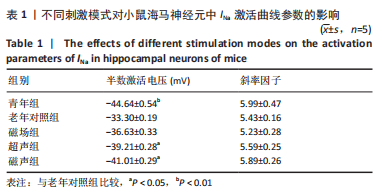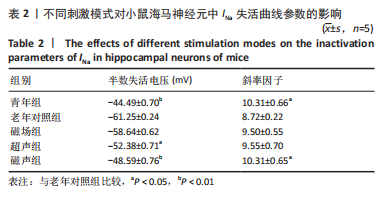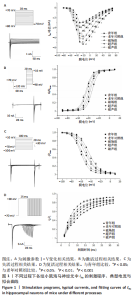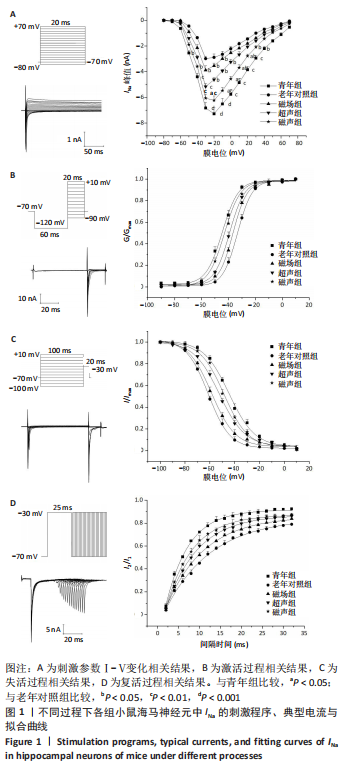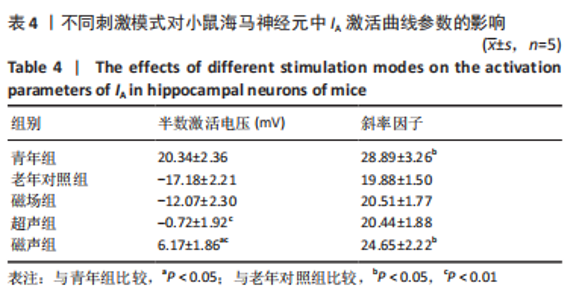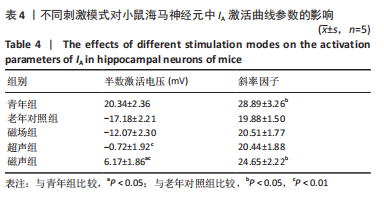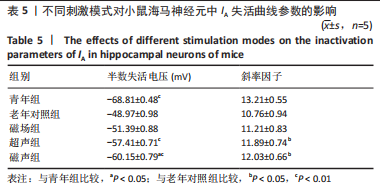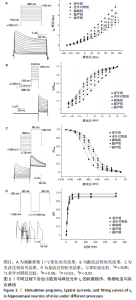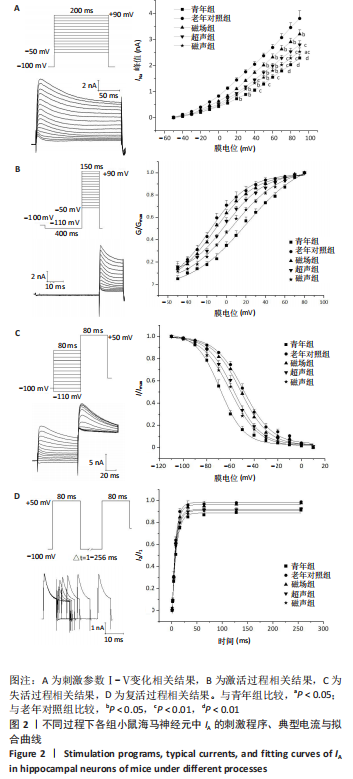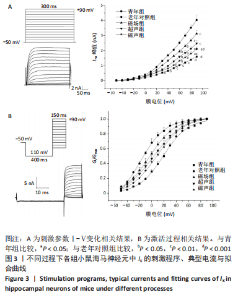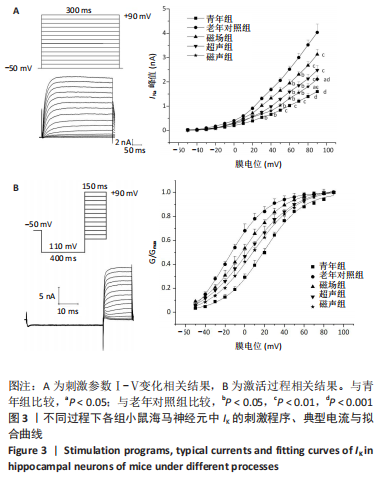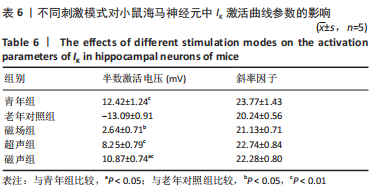[1] SPULBER D. Coping and resilience in life-long learning and ageing: new challenges. Geopolitical, Social Security and Freedom Journal. 2019;2(1):93-103.
[2] 杨云竣,黄飚.阿尔茨海默病与帕金森病的影像组学研究进展[J].国际医学放射学杂志,2020,43(1):41-44.
[3] 孙丽丽,任鹏,李志鹏,等.人类海马亚区的连接结构及功能机制的MRI研究进展[J].科学通报,2021,66(35):4510-4523.
[4] RANDALL AD, BOOTH C, BROWN JT. Age-related changes to Na+ channel gating contribute to modified intrinsic neuronal excitability. Neurobio Aging. 2012;33(11):2715-2720.
[5] 刘涵慧,李会杰.老化认知神经科学:研究现状与未来展望[J].中国科学:生命科学,2021,51(6):743-763.
[6] 张帅,崔琨,史勋,等.经颅磁声电刺激参数对神经元放电模式的影响分析[J].电工技术学报,2019,34(18):3741-3749.
[7] STEPHEN JN. Can ultrasound be used to stimulate nerve tissue? BioMedCentral. 2003;2(1):6-14.
[8] YUAN Y, CHEN Y, LI X. Theoretical analysis of transcranial magneto-acoustical stimulation with Hodgkin-Huxley neuron model. Front Comput Neurosc. 2016;10(35):1-8.
[9] 赵松,刘丹,罗小元,等.经颅磁声刺激下分数阶扩展Hindmarsh-Rose神经元放电特性分析[J].电子与信息学报,2022,44(2):534-542.
[10] 韩姗姗,郝晓蔚,庞娜,等.基于Mean- Hodgkin-Huxley模型的经颅磁声刺激对神经元放电的调控作用研究[J].燕山大学学报,2021, 45(5):465-470.
[11] 刘世坤,张鑫山,周晓青,等.经颅磁声耦合电刺激技术应用于小鼠的实验研究[J].生物医学工程研究,2018,37(1):11-15.
[12] ZHOU XQ, LIU SK, WANG YX, et al. High-resolution transcranial electrical simulation for living mice based on magneto-acoustic effect. Front Neurosc. 2019;13:1342-1342.
[13] WANG H, ZHOU X, CUI D, et al. Comparative study of transcranial-magneto acoustic stimulation and transcranial ultrasound stimulation of motor cortex. Front Behav Neurosci. 2019;13(241):1-10.
[14] WANG Y, FENG L, LIU S, et al. Transcranial magneto-acoustic stimulation improves neuroplasticity in hippocampus of Parkinson’s disease model mice. Neurotherapeutics. 2019;16(4):1210-1224.
[15] 张帅,许家悦,李梦迪,等.基于皮层神经元模型的经颅磁声电刺激神经网络放电活动仿真分析[J]. 电工技术学报,2021,36(18):9.
[16] 张帅,武健康,许家悦,等.经颅磁声电刺激对前额叶皮层神经集群钙信号的影响[J].生物医学工程学杂志,2022,39(1):19-27.
[17] 张帅,党君武,焦立鹏,等.经颅磁声电刺激对大鼠工作记忆局部场电位gamma节律的影响[J].中国生物医学工程学报,2021,40(5): 540-549.
[18] 周术奎,张楷乐,王营,等.细胞膜片技术在组织工程中的应用与研究进展[J].中国组织工程研究,2016,20(11):1630-1636.
[19] WANG X, HOOKS BM, SUN QQ. Thorough GABAergic innervation of the entire axon initial segment revealed by an optogenetic ‘laserspritzer’. J Physiol. 2015;592(19): 4257-4276.
[20] KUMAR P, KUMAR D, JHA SK, et al. Ion channels in neurological disorders. Adv Protrin Chem Str. 2016;103:97-136.
[21] ZHANG JL, CHEN XL, EATON M, et al. Severe deficiency of the voltage-gated sodium channel NaV1.2 elevates neuronal excitability in adult mice. Cell Rep. 2021;36(5):109495-109495.
[22] 尤敏,朱静.电压门控离子通道参与紫杉醇所致周围神经病变的研究进展[J].世界科学技术-中医药现代化,2022,24(2):716-722.
[23] 陈小佳,谭涛,刘迢迢,等.大鼠海马CA1区锥体神经IA和IK在出生后早期的变化[J].生理学报,2013,65(2):193-200.
[24] 李珊,檀雅欣,习杨彦彬,等.电压门控性钠离子通道2B(SCN2B)在脑老化认知功能减退过程中对APP的加工处理和Aβ产生过程中发挥作用[C].中国解剖学会2019年年会,2019:143.
[25] 隋雨桐,朱明雪,梁华.衰老相关疾病模型的研究进展[J].中国临床保健杂志,2017,20(3):317-320.
[26] WASSERMANN EM, LISANBY SH. Therapeutic application of repetitive transcranial magnetic stimulation: a review. Clin Neurophysiol. 2001; 112:1367-1377.
[27] PANG N, HUANG XW, ZHOU H, et al. Transcranial ultrasound stimulation of hypothalamus in aging mice. IEEE Trans Ultrason Ferroelectr Freq Control. 2021;68(1):29-37.
[28] 杨雪宁,杨佳佳,万柏坤,等.低强度聚焦超声对中枢神经调控作用研究进展[J].生物化学与生物物理进展,2018,45(4):39-48.
[29] 王会琴,周晓青,刘世坤,等.经颅磁声刺激与经颅超声刺激诱发肌电运动阈值的对比研究[J].医疗卫生装备,2019,40(1):14-19.
[30] 尹晓楠,徐桂芝,朱海军,等.不同频率磁刺激对离体脑片神经元兴奋性及电压门控型钾通道影响的研究[J].生物医学工程学杂志, 2021,38(2):224-231.
[31] PAN XJ, LI ZQ, ZHOU Q, et al. Structure of the human voltage-gated sodium channel Nav1.4 in complex with β1. Science. 2018;362:6412.
[32] POULOPOULOU C, MARKAKIS I, DAVAKI P, et al. Aberrant modulation of a delayed rectifier potassium channel by glutamate in Alzheimer’s disease. Neurobio Dis. 2010;37(2):339-348.
[33] TAN T, XIE JC, TONG ZQ, et al. Repetitive transcranial magnetic stimulation increases excitability of hippocampal CA1 pyramidal neurons. Brain Res. 2013;1520(3):23-35.
[34] 杨惠娟.锰对心肌细胞钙稳态、活性氧以及细胞凋亡的作用机制研究[D].杭州:浙江大学,2007.
[35] 孙金垚.经颅磁声电刺激对神经元放电活动的影响及其动力学机制的研究[D].天津:河北工业大学,2020.
[36] 朱海军,丁冲,徐桂芝.膜片钳技术及其在神经科学研究中的应用[J].生命科学研究杂志,2017,21(3): 251-256.
[37] 王世刚,何乐民,游敏娟,等.组织电导率性质对磁感应磁声耦合成像声源强度的影响[J].中国医学物理学杂志,2021,38(7):871-876.
[38] JIANG Y, YANG XZ, JIANG JH, et al. Structural designs and mechanogating mechanisms of the mechanosensitive piezo channels. Trends Biochem Sci. 2021;46(6):472-488.
[39] 霍军,卢本卓,董昊.基于孔道突变的钙库控制钙离子通道的门控机制研究[J].化学物理学报,2021,34(6):915-924.
[40] 李谦,毕爱玲,王兴荣,等.模型动物神经元钙信号检测技术研究与进展[J].中国实验动物学报,2021,29(1):104-110.
|

